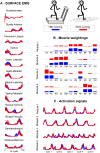Modular Control of Treadmill vs Overground Running
- PMID: 27064978
- PMCID: PMC4827843
- DOI: 10.1371/journal.pone.0153307
Modular Control of Treadmill vs Overground Running
Abstract
Motorized treadmills have been widely used in locomotion studies, although a debate remains concerning the extrapolation of results obtained from treadmill experiments to overground locomotion. Slight differences between treadmill (TRD) and overground running (OVG) kinematics and muscle activity have previously been reported. However, little is known about differences in the modular control of muscle activation in these two conditions. Therefore, we aimed at investigating differences between motor modules extracted from TRD and OVG by factorization of multi-muscle electromyographic (EMG) signals. Twelve healthy men ran on a treadmill and overground at their preferred speed while we recorded tibial acceleration and surface EMG from 11 ipsilateral lower limb muscles. We extracted motor modules representing relative weightings of synergistic muscle activations by non-negative matrix factorization from 20 consecutive gait cycles. Four motor modules were sufficient to accurately reconstruct the EMG signals in both TRD and OVG (average reconstruction quality = 92±3%). Furthermore, a good reconstruction quality (80±7%) was obtained also when muscle weightings of one condition (either OVG or TRD) were used to reconstruct the EMG data from the other condition. The peak amplitudes of activation signals showed a similar timing (pattern) across conditions. The magnitude of peak activation for the module related to initial contact was significantly greater for OVG, whereas peak activation for modules related to leg swing and preparation to landing were greater for TRD. We conclude that TRD and OVG share similar muscle weightings throughout motion. In addition, modular control for TRD and OVG is achieved with minimal temporal adjustments, which were dependent on the phase of the running cycle.
Conflict of interest statement
Figures






References
-
- Nelson RC, Dillman CJ, Lagasse P, Bickett P. Biomechanics of overground versus treadmill running. Med Sci Sports. 1972;4: 233–240. - PubMed
Publication types
MeSH terms
LinkOut - more resources
Full Text Sources
Other Literature Sources
Miscellaneous

